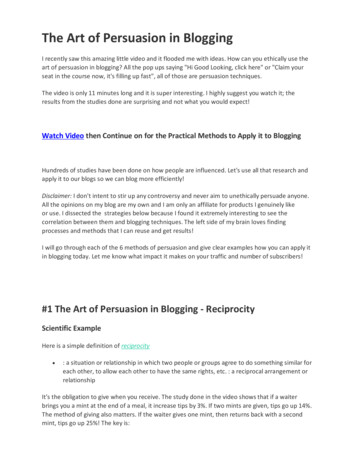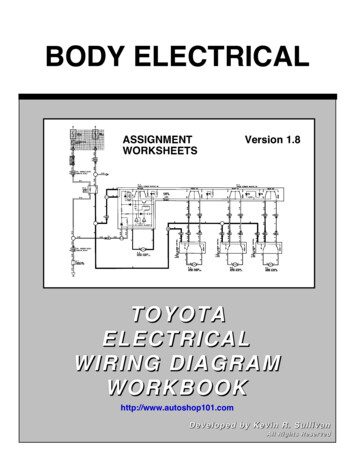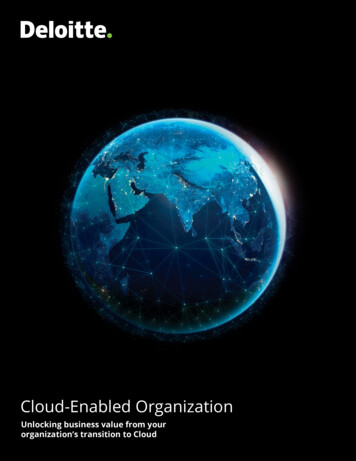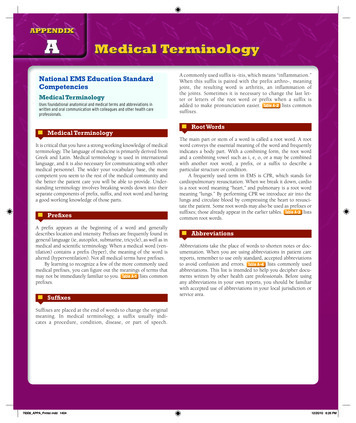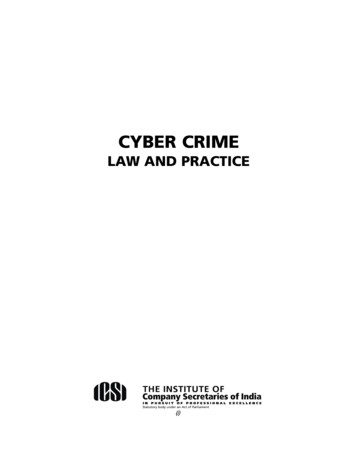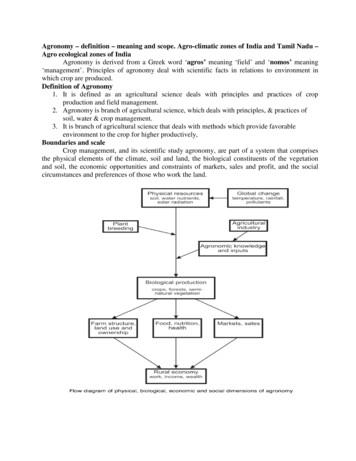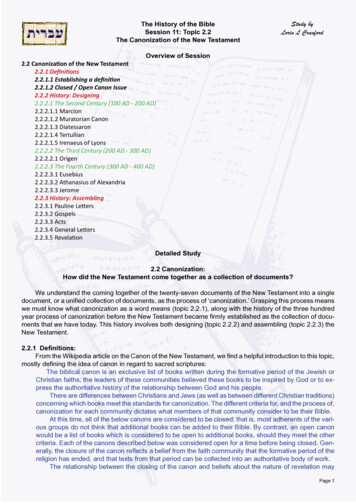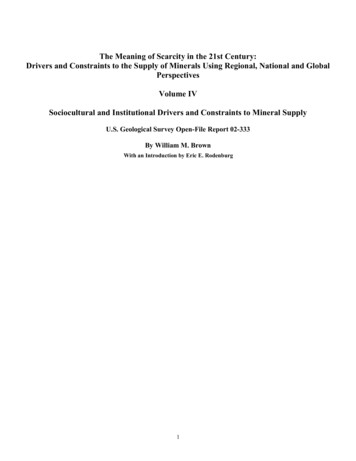
Transcription
The Meaning of Scarcity in the 21st Century:Drivers and Constraints to the Supply of Minerals Using Regional, National and GlobalPerspectivesVolume IVSociocultural and Institutional Drivers and Constraints to Mineral SupplyU.S. Geological Survey Open-File Report 02-333By William M. BrownWith an Introduction by Eric E. Rodenburg1
ContentsPageAbstract5Introduction to the Series by Eric E. Rodenburg6Introduction to this Volume: The Scope of Social Realities9Conservation and Environmentalism: 150 Years of Changing Values13The Sustainability Transition: A World Full of Hope and Promise21What is Sustainable Development?21Societal Perceptions About Mining26The Demand for Minerals40The Land Available for Mining47Mined Land in the United States47The Federal Estate Available for Energy and Minerals Development50Federal Land Withdrawals53Federal Land Use Trends and Mining55Non-federal Lands Available for Mining57Uncertainties Influencing Mineral Exploration59Parks and Protected Areas Around the Globe62Resolving Societal Issues: The Mining Industry’s Response to Sustainability64Social Challenges in Central America and South America65Canada’s Whitehorse Mining Initiative66The Business Implications of Sustainable Development: Rio Tinto Borax68The Global Mining Initiative: Mineral Supplies and Sustainable Development72The Mining, Minerals and Sustainable Development Project752
Summary80Selected References88Selected Internet References98Appendix A.The Crandon Mining Project, Wisconsin104Twenty-Six Years of Debate and Changing Values104Mining and the Sociocultural Environment in Wisconsin:Inextricably Bound and Changed108Selected References118Selected Internet References1183
The § indicates that the source is an Internet site, the citation for which is located in the sub-section “Selected Internet References”within the sections “Selected References”.4
AbstractThe sociocultural dimensions of mineral supply at the outset of the 21st century are making the supply processincreasingly complex. The dimensions encompass legal, financial, environmental, cultural, and globalimplications of mining, and are driving unprecedented change in the way minerals supply will be accomplishedin the future. Minerals scarcity on a global scale is subordinate to other societal issues about mineral resourcesand reserves estimated to meet society’s demands for decades to centuries in the future.This report reviews historical and present-day sociocultural drivers of change, and reactions of the mineralsindustry to these drivers. It is reflective primarily of conditions in the United States, but also uses examplesfrom other countries. It expresses viewpoints on sociocultural drivers as seen by constituents of the mineralsindustry and several other communities of interest including Aboriginal peoples, non-government organizations;labor; mining-dependent communities; mining-affected communities; researchers; and government (federal,state/provincial, and local). It provides overviews of the demand for minerals in the United States, and thestatus of land available for mining. The report uses a case study of a metals mining project in Wisconsin toillustrate specific sociocultural drivers and constraints to minerals supply, and how these influence the mineralsindustry.Over the past 150 years, a progression of sociocultural movements under the headings of conservationism,environmentalism, and sustainable development have nurtured societal values that have come to influence themineral supply process in important ways. These movements reflect a continuing tension between the demandfor minerals and other resources, and the simultaneous demand for aesthetic, spiritual, ecological, cultural, andother attributes of the land. The tension is an important element in current international debates about themeaning and future of sustainable development. This report focuses on some of the social challenges to theminerals industry to supply minerals, while at the same time providing environmental protection, economicgrowth, and sociocultural acceptance. All these issues fall under the rubric of sustainable development. It alsodescribes current industry responses to sustainability, including the Global Mining Initiative (2001a§), anattempt to introduce major changes in global industry practices to begin the 21st century. This reportcomplements other documents in the series on physical supply, technological advancement, and economic andpolicy drivers (Wilburn and others, 2001§).5
Introduction to the Series by Eric E. RodenburgThe possibility of future mineral scarcity is an important concern of environmental activists, those desiring tolimit population growth, and those concerned with wealth distribution between industrialized and developingcountries. Through the years, observers from Thomas Malthus (1798) to the 1972 Club of Rome (Meadows andothers, 1972), for example, predicted exhaustion of resources at various dates, most of which have come andgone without the dire consequences of societal collapse they envisioned.The static model from which these predictions came continues to inform many who choose to believe thatmineral production cannot meet the material aspirations of a rapidly growing world population if consumptionof some resources continues to increase. The perception of future scarcity, for example, motivated the FactorTen Club, a group of resource economists, to issue the Carnoules Declaration in 1994 and 1995. TheDeclaration called for a swift 10-fold increase in material efficiency among industrialized countries to freematerials for people in developing countries (Factor 10 Club, 1995).The concerns of future scarcity may in part be caused by misinterpretation and (or) the misuse of publishedmineral reserve estimates for non-fuel mineral commodities. A reserve is that part of an in-place demonstratedresource that can be economically extracted or produced at the time of estimation (U.S. Bureau of Mines andU.S. Geological Survey, 1980). Some misinterpret the term “reserve” as an estimate of all that is left of aresource.Mineral supply starts with the physical existence of materials, and can be no greater than its occurrence in theEarth’s crust. The amount of material actually supplied to society (economic supply) is that which is calledforth by demand (willingness-to-pay), as moderated by the cost of production, which is influenced by physicalrealities, technology, politics, and social concerns.In fact, many of the minerals that the Earth’s population demands exist in nearly inexhaustible amounts.Additionally, there is an enormous stock of resources in materials in-use (machinery, buildings, and roads) andin unutilized waste (landfills). There is, however, a growing understanding that physical scarcity is not theonly, or even the most, important issue. Industrial activities extract and transform resources into productspeople use. In many cases, these activities come with direct or accumulative environmental consequences that6
can pose serious threats to ecosystems and human health. Thus, the important issue of scarcity may be thecapacity of Earth’s geologic, hydrologic, and atmospheric systems to assimilate the wastes (Meadows andothers, 1972).This series, “Scarcity in the 21st Century”, addresses resource constraints and opportunities, and the effects oftheir interactions on resource supply. Assessing potential supply requires a whole systems approach, both inphysical terms by looking at the flows of materials through the economy, and in human terms by integrating theinteractive domains of economics, environment, policy, technology, and societal values.In 1929, D.F. Hewett, of the United States Geological Survey (USGS), reflecting on the effects of war on metalproduction, identified four factors he deemed most important in influencing metal production (Hewett, 1929).1. Geology“First, there are the geological factors, which are concerned with the minerals present; their number and kind,which determine whether the problem of recovery is simple or complex; the degree of their concentration ordissemination; their border relations; the shape and extent of the recognizable masses.”2. Technology“Second, there are the technical factors of mining, treatment and refining. A review of these leaves a vividimpression of the labor involved in their improvement but they necessarily yield cumulative benefits.”3. Economics“The third group of factors that affects rates of production are economic, and among these factors cost andselling price are outstanding. Since 1800 the trend of prices for the common metals, measured not only bymonetary units but by the cost in human effort, has been almost steadily downward ”4. Politics“The fourth group of factors that affect metal-production curves are political or lie between politics andeconomics.”7
The four factors do not operate separately, but rather as parts of an integrated system, which also includes socialconstraints and drivers such as environmental issues and the structure of the mining industry.“Scarcity in the 21st Century” is composed of six chapters to be published in a series of USGS Open FileReports and then compiled as a USGS Circular.Chapter 1: “The Supply of Materials” examines the physical supply of minerals on the planet, in the ground andproducts-in-use, waste streams, and waste deposits (landfills). Current and future potential for recycling ofproducts-in-use and landfill materials are examined.Chapter 2: “Economic Drivers of Mineral Supply” explores price, investment, costs, and productivity, and theirrelevance to supply.Chapter 3: “Technological Advancements – A Factor in Increasing Resource Use” investigates the impact oftechnological change on mineral extraction, processing, use and substitution.Chapter 4: “Sociocultural and Institutional Drivers and Constraints to Mineral Supply” addresses social realitiesthat affect mineral supply, nationally and globally, and the sociocultural trends that promise to have an impacton future supplies.Chapter 5: “Policy – A Factor Determining the Parameters of Minerals Supply and Demand” examines theeffect of government policies that either promote or restrain mineral development, some of which include:access, title, regulation, rent, royalty, and tax fees, and direct and indirect subsidies. This volume also discussesthe affects of corporate policies on mineral supply.Chapter 6: “Overview of Minerals Supply” presents an overall view of these parameters of supply to show theirsynergy in supply and ultimately production.Each chapter contains ample reference to historical information about one or more commodities to illustrate theconcepts.8
Introduction to This Volume: The Scope of Social RealitiesSociocultural trends at the beginning of the 21st century are making the concept of mineral supply increasinglymore complex. Whereas technological advances in mining and processing mineral materials continue to expandthe services of minerals to meet human demands, competing sociocultural forces are having powerful influenceson the processes of supplying minerals to meet these demands. Typical issues facing mineral suppliersthroughout the world comprise numerous social and environmental concerns that tend to alter or inhibit themanner in which exploration and mining have been traditionally conducted.Balkau and Parsons (1999, p. 1) offer examples of major issues facing mining (p. 10, this volume). Thecommentary suggests that there is a fast-moving environmental agenda driving attention to the issues, and thatthe agenda is a composite of environmental, technical, and socioeconomic trends that are global in scope. Thespirit of this agenda is partly encapsulated in the idea of sustainable development, originally designed as apolicy option of the United Nations (World Commission on Environment and Development, 1987), anddebated, expanded and refined throughout the world since that time. Because the idea of sustainabledevelopment is now so widespread among governments, international organizations, nongovernmentorganizations (NGOs) and others, it has come to be a major factor that could affect mineral production.9
AN OVERVIEW OF THE INTERNATIONAL ENVIRONMENTAL AGENDA FOR MININGNot only is the environmental agenda moving, but it is also moving fast. The following listincludes the major environmental issues for mining as seen in 1999 by the United NationsEnvironment Programme: Destruction of habitat and biodiversity at the mine site Ecosystem/habitat/biodiversity protection in adjacent land Landscape/visual impact/loss of land-use Site stabilization and rehabilitation Mine waste/tailings disposal Sudden failure of tailings facilities Abandoned equipment, solid waste, sewage Air emissions Dust Climate change Energy consumption Siltation and changes in river regimes Effluent discharges and acid drainage Groundwater alteration or contamination Hazardous wastes and chemical residues Hazardous chemicals handling, safety, workplace exposure Noise Radiation Workplace health and safety The impact of metals toxicity on the marketing of metals Cultural and archaeological values Public health and urban settlement issues around mines-- Balkau and Parsons (1999, p. 1).10
Major sociocultural trends affecting mineral supplies include increasing access to global communications andtransportation for a vast number of people, and a proliferation of nongovernmental organizations (NGOs) thateffectively shape public opinion. The recent and worldwide ascendancy of NGOs that are critical of mining,together with the communications resources provided by the Internet, allows global monitoring of mining andrapid distribution of potentially negative information. This means that far greater numbers of even the lessattentive public now visit, read about, or view today’s mining activities (or the consequences of mining tens tothousands of years ago) and form immediate opinions about mining. Mining at the outset of the 21st century, toan extent unprecedented in human history, is seldom isolated from public scrutiny and more open than ever topublic perceptions that are often negative.Sociocultural drivers reside in human beliefs and values that often take precedence over the physical facts ofmineral supplies and demands that include, for example, the quantities of materials in the Earth’s crust and thewater-quality and other physical expressions of mining. This discussion attempts to examine mineral supply ina way that goes well beyond its physical and economic dimensions. Here the focus is on social realities, bothnationally and globally, that have influenced mineral supply in the past, and some sociocultural trends thatpromise to have an impact on future supplies. This is no simple task, as sociocultural issues are both rapidlychangeable and virtually boundless. Additionally, the discussion surrounds differences between individuals andorganizations in communicating about sustainable development and environmental issues connected withmineral supplies. The worlds of geology, mining, and mineral economics, for example, come with concepts andvocabularies that are typically unfamiliar to, and easily misinterpreted by groups like NGOs, policymakers,indigenous peoples, and the general public. The worlds of ecology, preservation, and sustainable developmentalso come with domains and expressions that can be alien to these same groups as well as to members of themining and minerals community.Other reports in this series discuss nonfuel minerals, and exclude, for example, coal, oil, and gas. However, forthoroughness and perspective, this volume goes beyond distinctions about types of minerals and even about thespecific activity of mining. Sociocultural perspectives on mining commonly do not distinguish among practicesused to mine different kinds of minerals, and often focus on activities ancillary to mining itself. For manypeople, disrupting the land surface for minerals extraction in many cases is not appreciably different fromactions taken in other types of extractive and industrial practices. Critics of these practices focus on thenegative aspects of noisy machinery, roadbuilding, removing surface vegetation and soil, excavating and11
displacing bedrock, creating impervious surfaces, altering local hydrologic systems, generating wastes andpollution, fragmenting or obliterating the pre-existing ecosystem, and potentially transforming the local socialand cultural tapestry. Case studies on the Crandon Project in Wisconsin (Appendix A.) and aggregate supplyand demand in the mid-Atlantic United States (Robinson and Brown, 2002§) serve to illustrate how theseaspects are viewed and how they influence the complex sociocultural dimensions of obtaining and ensuringmineral supplies.Debates about mineral supplies also have many parallels to debates about scarcity or abundance of otherrenewable and nonrenewable natural resources. For example, significant findings (Rock, 2000; U.S. GeologicalSurvey, 1998) about water use, water scarcity, and the intensity of water use as economic development proceedscould provide valuable insights into understanding similar issues about minerals and other resources. Inaddition, the discussion in this document occasionally touches on issues of resource extraction for materials likewood and water, particularly where these issues help illuminate the reasons why people accept or resist mineralextraction.Given a wide diversity of opinion and political action, not all lands rich in resources are available for mining,logging, and similar activities. Thus, investigators cannot afford to look at resource supply and environmentalquality in isolation from the physical and social systems of which they are a part. This report draws from manysources to examine aspects of the changing nature of minerals supply, competing sociocultural views aboutsupply and demand, and commentaries on the ethics, aesthetics, theology and other facets of obtaining theminerals demanded by modern society.This report briefly reviews conservation and environmental movements in the United States and elsewhere toprovide background about social values that potentially affect mineral supply. It treats the evolution of ideasabout creating a transition to sustainable development, and refers to practices such as industrial ecology andcultural phenomena like globalization that potentially influence the role of minerals in sustainable development.It reviews current and projected minerals demand in the United States, and assesses the status of land availablefor mining. It examines the mining industry’s response to the sustainability transition, and offers case studies tohelp illustrate what society is asking of the industry in terms of mineral supplies, environmental protection, andsocial values, and what the industry is requiring of itself at the outset of the 21st century.12
Conservation and Environmentalism: 150 Years of Changing ValuesThe concepts of conservationism and environmentalism have evolved over many years (Kovarik, 2000§) tohave important impacts on national and global social policy at the outset of the 21st century. Particularly,values arising from conservationism and environmentalism have strongly influenced both the policies applied toresource extraction and the practices of those who supply the resources society demands. These values havechanged over time from minor public skepticism about the effects of garnering resources to widespreaddisapproval over any actual or imagined harmful impact on the environment (Marcus, 1997, p. 35). The results,particularly by the later years of the 20th century, have manifested themselves as entrenched differences ofopinion throughout society about the nature of activities (mining, logging, fishing, manufacturing, agriculture)that provide the fundamental materials and sustenance that humans either require or would like to have. Muchof the conflict arises because beliefs about what constitutes conservation or environmental protection areelusive. Moreover, the full dimension of the human relationship with the environment remains under intensivescientific scrutiny, and has yet to be fully understood in terms of such contemporary issues as greenhouse gases,biodiversity, and the capacity of the environment to assimilate anthropogenic wastes.The environmental movement of the 1960s to the 1990s arose from a conservation movement manifested in theUnited States in the latter half of the 19th century (The Library of Congress, 2001§; Kovarik, 2002§). Hague(1977§) suggests: “If the first phase of American history, in which a dominant theme was the advance of thefrontier, ran from 1607 to 1890, the second phase began with the emergence of the conservation movementwhich would lead to the alteration of fundamental attitudes toward the land nurtured during the first phase.”Those fundamental attitudes included the assumption by frontiersmen that the American West containedinexhaustible resources. Hague (1977§) refers to two factions of the conservation movement. One was arefinement of the frontier view of exploitation described as promoting “utilitarian conservation” that“ advocated the careful use of finite resources, without rejecting the basic assumption that the resources werethere to be exploited.” The other faction, described as advocating “aesthetic conservation,” argued forpreservation of natural land for its own sake and for public enjoyment. This group’s activities led to measuringenvironmental values in other than strictly economic terms, and to the establishment of national and state parks,monuments, and wilderness areas. The full expression of a conservation movement, attributable to the powersof persuasion of leaders over the years like George Perkins Marsh, John Muir, Gifford Pinchot, and JohnWesley Powell (Marcus, 1997, p. 12) set the stage for land-use policy conflicts that have remained on thenation’s political agenda throughout the past 100 years. A subsequent section of this report (p. 47, this volume)13
reviews some of the conflicts that have evolved since the onset of the conservation movement regarding thepurpose and use of national lands, and what these portend for future mineral supplies on such lands.The changes in human and social values engendered by conservationism and environmentalism over the past150 years are pronounced. Trends in changing values are exemplified by the eras defined for the evolution ofthe U.S. Forest Service that include 1905 through 1945 as the “Forest Protection Era,” 1946 through 1969 as the“Managed Forest & Multiple Use Era,” and 1970 through 2001 as the “Environmental & Ecological Era”(USDA Forest Service, 2001§). Concepts that once seemed extraordinary, such as environmental protection,are now commonplace in societal institutions. New concepts such as responsible consumerism, environmentaljustice, intra- and inter-generational equity, and sustainability are now prominent in international debate.Shabecoff (2000, p. 5) noted for the United States: “Public concern for the environment became a flood thatcould not be contained (on Earth Day, April 22, 1970) environmentalism emerged for the first time on thenational stage as an unmistakable mass movement.” Particularly during the years since 1970, the strength andevolution of environmental values has fueled the growth of environmental protection policies throughout theworld. These policies are evidence that at least some form of environmentalism is now strongly imbedded inmany parts of global culture. In the United States, for example, most Americans consider themselves to beenvironmentally aware, and attention to environmental issues is unprecedented (Danni, 1997, p. 719). Ashumanity enters the 21st century, the right to a healthful environment is becoming more and more central toglobal values.Environmental concerns can be important drivers of national and global economies as well as internationaldiplomacy. In many cases, environmental drivers of international relations have come to be as influential as thetraditionally dominant activities, such as diplomacy related to military security issues (Brown and others, 2000,p. 28). For such reasons, environmentalism continues to grow and change as part of broader unifying visions(such as sustainable development) to confront global challenges (p. 22, this volume). Shabecoff (2000, p. 10)asserts:“In the 20th century, environmentalism provided an intellectual and ethical context that enabledAmericans, and people in much of the rest of the world, to see the harm that human activity wasinflicting on the natural world. It established a legal and institutional infrastructure to help them come togrips with these ills and enlisted an army of activists, governmental and nongovernmental, at the local,14
national, and international levels, to work on solutions. An esoteric enthusiasm for a small elite at thebeginning of the century, environmentalism had been transformed into a planet-wide value by its end.”One of the appeals of environmental values lies in the idea that the environment cannot be viewed as some sortof medium that is separate from human life. As John Muir (1869) wrote, “When we try to pick out anything byitself, we find that it is bound fast by a thousand invisible cords that cannot be broken to everything in theuniverse.” Shutkin (2000, p. 126-141) uses the term “civic environmentalism” to describe the emerging modelof social and environmental activism for the 21st century. Whereas environmentalism of the past few decadeshas concentrated on specific media or pollutants, civic environmentalism treats overall health and quality of lifein a combination of social, economic, and environmental terms. The vision is one of sustaining – andincreasing – the health and quality of life of communities over time. Civic environmentalism tends to implythat communities and society in general will come to understand and appreciate the demand for resourcestogether with the consequences of extracting resources. In concert, extractive industries will engage societyusing ecological thinking while offering a more holistic approach to their work and its impacts. Shutkin (2000)describes a model that encompasses six principles described as a framework for moving towards sustainability(p. 16, this volume).15
Civic Environmentalism: A Framework for Moving Towards Sustainability“Environmentalism is evolving from an essentially elitist movement accompanied by a complex system oflaws and policies fixated on preserving undeveloped land and resources and controlling pollution frommajor sources to a more democratic call for healthy, sustainable communities across geographic, economicand cultural lines. Instead of merely reacting to environmental changes and decrying the pollution andwaste generated by our liberal capitalist economy, an expanding environmental constituency is devisingalternatives to traditional approaches to economic development and environmental protection. One needonly look at the host of environmental initiatives launched in the 1990s, and the emergence of a new field ofdesign and engineering called industrial ecology to see the transformation. In their best light, these andother initiatives are aimed at not only cleaning up the nation’s air, water, and soil, but making Americancommunities more livable and the economy more sustainable.”“I call this new approach civic environmentalism because it marries a concern for the physical health ofcommunities with an understanding that part and parcel of environmental quality is overall civic health.”“At the heart of civic environmentalism are six core concepts that provide a solid theoretical framework: 1)Democratic process – engaging a critical mass of stakeholders united by place and time in the project ofrebuilding and communities’ social, economic and physical fabric; 2) Community and regional planning –integrating law, science, fiscal policy, governance mechanisms, and civic will in systems-orientedenvironmental strategies; 3) Education – building greater awareness among citizens of the environmentaland social costs of their actions (‘environmental literacy’) and enlisting them in the process of identifyingand remedying environmental harms; 4) Environmental justice – embedding in all environmental strategiesa concern for lower-income people and communities of color, who have been disproportionately burdened byenvironmental harms in the past and must be directly engaged in environmental decisionmaking; 5)Industrial ecology – the principles of pollution prevention and sustainability as applied to the design andproduction methods of firms and to economic development generally and the theoretical framework for whatecoarchitect Bill McDonough (1992§, 1998§) and others are calling the next industrial revolution; and 6)Place – the physical and emotional space we occupy that inspires civic action.” (Shutkin, 2000).In another view of evolving environmentalism, Mol and Sonnenfeld (2000) describe five clusters of roles ofsocial and institutional transformations as superior to physical improvements in ecological modernization. Theysee science and technology valued for their actual and potential role in curing and preventing environmentalproblems. Here, science and technology move beyond traditional remediation measures to preventive sociotechnological approaches that incorporate environmental considerations from the design stage of projects. Theyemphasize the increasing importance of market dynamics and economic agents (such as producers, customers,consumers, credit institutions, insurance companies and others) as carriers of ecological restructuring andreform. They foresee transformations in the role of the nation-state wherein less centralized, more flexible andconsensual styles of governance emerge, with less top-down, national command-and-control environmentalregulation. This allows the private s
The Meaning of Scarcity in the 21st Century: Drivers and Constraints to the Supply of Minerals Using Regional, National and Global Perspectives Volume IV Sociocultural and Institutional Drivers and Constraints to Mineral Supply U.S. Geological Survey Open-File Report 02-333 By William M. Brown 1 With an Introduction by Eric E. Rodenburg

